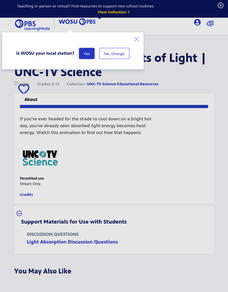SciShow
Cloaking Devices!
Cloaking devices aren't just for Star Trek and Harry Potter any more! Here's a video that explains how cloaking devices work, or don't work. It details the technology needed to perfect cloaking and offers ideas for where researchers...
Veritasium
Seeing the Invisible: Schlieren Imaging in Slow Motion
Heat rises, but what does that actually look like? The video shows many examples of air currents, such as a burning match and squeezing helium out of a balloon. It highlights common observations that are rarely seen such as gas vapors...
Physics Girl
How Rainbows Form
Somewhere over the rainbow ... the sky appears to be darker than below it? Why is that? A video from an interesting physics playlist illustrates the interaction between the visible spectrum and droplets of rain. It also doubles the...
Be Smart
Why Is Blue so Rare in Nature?
Why so blue? As it turns out, very few things in nature only reflect blue light! A short video from a comprehensive science playlist highlights the beautiful blues of butterflies, birds, and human eyes. The narrator shows how adaptations...
PBS
Light Absorption: Effects of Light | UNC-TV Science
Beat the summer heat by exploring the properties of color. Scientists view a video explaining the relationship between light absorption and energy transfer using variables including intensity, time, and wavelength. A multiple-choice...
Deep Look
What Gives the Morpho Butterfly Its Magnificent Blue?
Things are not always as they appear. The morpho butterfly appears to have blue wings, but they don't contain a drop of blue pigment. Learners watch as the instructor explains the physics behind these amazing blue wings.
PBS
Light Scattering: Effects of Light | UNC-TV Science
A video lesson describes how light absorbs, reflects, and scatters on different surfaces. Pupils learn the result of these different reactions and how humans perceive them.
Khan Academy
The Mohorovicic Seismic Discontinuity
The phenomena observed in the behavior of waves and data received from seismographs can lead us to various conclusions about the densities of material that waves are passing through.
Curated OER
Why S-Waves Only Travel in Solids
Starting with a very clear diagram to demonstrate how a wave actually forms, an informative video will be a great summary about s wave travel. It explains the difference between polar bonds in liquids versus the stronger ionic and...
Curated OER
Seismic Waves
Use a video on seismic waves to explain the differences between s and p waves, as well as the details that they provide about the composition of the rock.
Crash Course
Spectra Interference: Crash Course Physics #40
Finally, a lesson to brighten up the place! The 40th installment of the Crash Course physics series explores the physics of a light source. The narrator examines patterns between light and films and studies the oscillation patterns of...
Domain of Science
The Map of Physics
Aristotle said, "The more you know, the more you know you don't know." Physics includes everything from the laws of motion to quantum gravity. An interesting video attempts to cover the main concepts of every branch of physics in only a...
Other popular searches
- Light Refraction
- Reflection and Refraction
- Light Reflection Refraction
- Refraction of Light
- Index of Refraction
- Reflection Refraction
- Science Light Refraction
- Absolute Index of Refraction
- Wave Reflection Refraction
- Diffraction and Refraction
- Light Refraction Water
- Angle of Refraction













